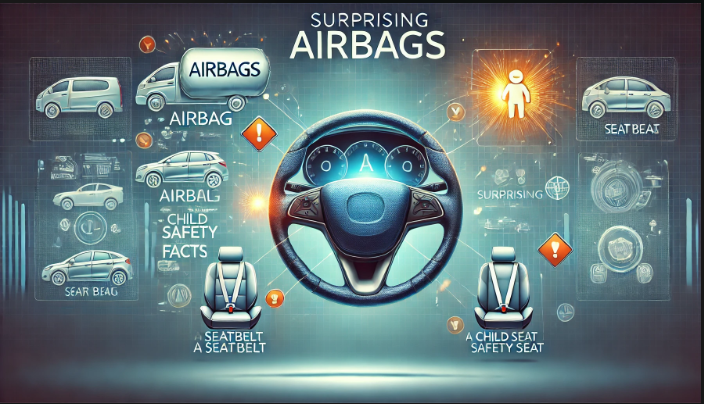Surprising Airbag Facts That Every Driver Should Be Aware Of

Airbags protect car occupants during crashes, but understanding their function and effectiveness is key. This article explains how airbags work, explores the available types, and addresses common myths about their safety role. It also provides surprising facts and safety tips to help you fully benefit from this crucial technology.
What Is An Airbag And How Does It Work?
An airbag is a safety feature designed to protect vehicle occupants, both driver and passenger, in a crash by deploying rapidly to cushion the impact and reduce injuries. When a vehicle crashes, the airbag control module using accelerometers triggers the deployment of airbags, which use explosive charges to inflate in milliseconds.
The deployment speed and efficiency of airbags are crucial to ensuring maximum safety, as per NHTSA safety standards followed by automakers like General Motors, Mercedes-Benz, and Chrysler. These airbags—front and side airbags—are part of modern car safety technology.
What Are The Types Of Airbags?
Airbags are categorized into different types, each designed to address specific safety needs in a vehicle crash to protect both driver and passenger.
The main types of airbags are front airbags, which deploy from the steering wheel and dashboard in frontal impacts; side airbags, which provide lateral protection in side crashes; knee airbags, which protect lower extremities in a collision; and curtain airbags, which deploy from the roof to protect occupants in side impacts and rollover accidents.
Each type serves a purpose and contributes to overall vehicle safety.
Front Airbags
Front airbags are designed to protect the driver and front passenger in a crash by inflating from the steering wheel and dashboard. Based on the crash severity, they deploy in milliseconds, helping reduce the risk of fatal injury by 29% for front-seat occupants. However, seatbelts are essential for airbags to work effectively, as they are meant to complement, not replace, seatbelts.
Side Airbags
Side airbags protect in side-impact crashes by deploying from the side of the seat or vehicle door. They create a barrier between the occupant and hard surfaces, reducing the risk of severe injuries, particularly to the head. Manufacturers design these airbags to adjust deployment based on the crash severity and the occupant’s position, making them a key safety feature in modern vehicles.
Knee Airbags
Knee airbags under the steering column and dashboard protect the lower extremities in a crash by cushioning the legs and preventing them from hitting hard surfaces. These airbags are crucial in frontal crashes, helping to reduce leg and knee injuries, which are common in these accidents.
Curtain Airbags
Curtain airbags deploy from the roof to protect the occupant’s head in side impacts and rollover crashes. They act as a barrier between the occupants and the inside and outside of the vehicle, significantly reducing the risk of head injuries. Crash tests show that cars with curtain airbags perform better in safety ratings, highlighting their importance in modern car safety.
How Effective Are Airbags In Preventing Injuries?
When appropriately deployed, airbags are very effective in preventing injuries in vehicle crashes and reducing the risk of severe injuries to drivers and passengers. Research and safety statistics show that airbags with seatbelts can reduce fatal injuries by 30%.
They deploy quickly in response to crash sensors to mitigate the crash’s impact, which is why they are part of modern car safety systems. Despite their effectiveness, immediate medical attention is still needed to treat any injuries in case of an accident. That’s where 1-800-ASK-GARY can help, connecting you with medical professionals specializing in accident injuries to ensure you get the care you need.
What Are The Myths About Airbags?
Despite their critical role in car safety, several airbag myths persist, leading to misunderstandings about their function and importance. One myth is that airbags are dangerous, particularly for children or small passengers, when in reality, proper use with seatbelts enhances overall safety.
Another misconception is that airbags only deploy in frontal crashes, whereas modern vehicles have airbags designed for various crash scenarios, including side impacts and rollovers. Additionally, the belief that airbag replacement is prohibitively expensive discourages repairs, though costs are often lower than expected and can be covered by insurance.
Understanding these myths and the actual workings of airbags is essential for ensuring proper safety measures and maintaining vehicle integrity.
What Are The Surprising Facts About Airbags?
Many people might need to realize airbags’ full impact on vehicle safety, with statistics showing they have saved thousands of lives since their introduction. Airbags are designed differently across car models, reflecting the priorities of various manufacturers, and they’re not meant to replace seatbelts but to work alongside them to enhance safety.
Although airbags primarily deploy during crashes, they can also activate in non-crash situations like sudden braking or hitting potholes, which can be confusing. Understanding these aspects helps drivers appreciate the critical role of airbags in automotive safety and the continuous advancements in this technology.
Airbag Safety Precautions
Airbag safety precautions are essential for protecting all vehicle occupants, especially children, in the event of a crash. Key practices include always wearing seatbelts, sitting at least 10 inches away from airbag deployment zones, and ensuring children are correctly secured in the back seat. Buckling up enhances the effectiveness of airbags by keeping occupants in place, reducing the risk of serious injury. Maintaining a safe distance from the airbag minimizes the chance of injury during deployment. Additionally, it’s important not to place any objects on the airbag cover, as they can interfere with deployment and increase injury risks. By following these guidelines, you can significantly improve safety for everyone in the vehicle.





